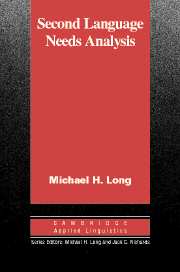Book contents
- Frontmatter
- Contents
- List of contributors
- Acknowledgments
- Overview: A rationale for needs analysis and needs analysis research
- I Methodological issues
- II The public sector
- III The occupational sector
- Chapter 4 Sources, methods and triangulation in needs analysis: A critical perspective in a case study of Waikiki hotel maids
- Chapter 5 Foreign language need of business firms
- Chapter 6 Evaluating the use of multiple sources and methods in needs analysis: A case study of journalists in the Autonomous Community of Catalonia (Spain)
- Chapter 7 “Feet speak louder than the tongue”: A preliminary analysis of language provisions for foreign professional footballers in the Netherlands
- IV The academic sector
- V Analyzing target discourse
- Index
Chapter 6 - Evaluating the use of multiple sources and methods in needs analysis: A case study of journalists in the Autonomous Community of Catalonia (Spain)
Published online by Cambridge University Press: 25 January 2010
- Frontmatter
- Contents
- List of contributors
- Acknowledgments
- Overview: A rationale for needs analysis and needs analysis research
- I Methodological issues
- II The public sector
- III The occupational sector
- Chapter 4 Sources, methods and triangulation in needs analysis: A critical perspective in a case study of Waikiki hotel maids
- Chapter 5 Foreign language need of business firms
- Chapter 6 Evaluating the use of multiple sources and methods in needs analysis: A case study of journalists in the Autonomous Community of Catalonia (Spain)
- Chapter 7 “Feet speak louder than the tongue”: A preliminary analysis of language provisions for foreign professional footballers in the Netherlands
- IV The academic sector
- V Analyzing target discourse
- Index
Summary
Introduction
The purpose of this paper is two-fold: (i) to describe a research project on the analysis of the English-language needs of journalists in the Autonomous Community of Catalonia, Spain; (ii) to evaluate the use of multiple sources and methods in needs analysis (NA).
The NA framework for this study was that provided by Long (this volume). Long suggests that previous NA models, such as that of Wilkins (1976) or Munby (1978) in the 1970s, although useful at the time, were in fact based on the intuitions of applied linguists about the notions and functions required by learners, and not on empirical studies. Since then, work on such models has generated pedagogical materials that have “focused on the notions and functions supposedly required to satisfy various occupational language needs.” (Long, this volume, p. 21). Still today, the majority of NAs that can be found in the literature rely on outsiders' views (basically learners and applied linguists) rather than on insiders' views (domain experts). In addition, most NAs limit themselves to reporting findings and few ever discuss the reliability or validity of their methodology.
Long advocates use of multiple sources and methods, as well as triangulation by sources and/or by methods, in order to improve the reliability and validity of findings. In Long's model, linguistic units (such as words, structures, notions or functions) are replaced by ‘task’ as the unit of analysis. A few studies have started reporting the efficacy of multiple sources and methods (Svendsen & Krebs, 1984; Jasso-Aguilar, 1999, this volume).
- Type
- Chapter
- Information
- Second Language Needs Analysis , pp. 182 - 199Publisher: Cambridge University PressPrint publication year: 2005
- 24
- Cited by



